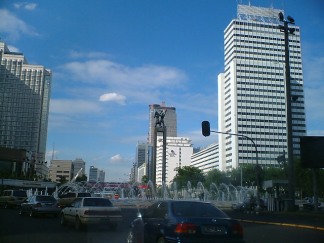One of the Unique Collections of the Jakarta History Museum
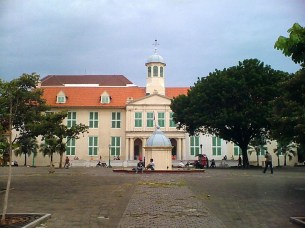
Museum Sejarah Jakarta/ The Jakarta History Museum (foto: arie saksono)
If you have time, take a visit to Museum Sejarah Jakarta or Jakarta History Museum, the formerly Batavia City Hall, Stadhuis van Batavia. Beside all the collections displayed in the museum, have a look at the big old bronze cannon at the backyard of the museum. The cannon have been transferred many times. The formerly location was near the old drawbridge (ophaalbrug-Dutch) Kota Intan at Kali Besar Street, West Jakarta, in the area of the demolished castle Batavia, then it was placed on the front yard, on the northern side of the museum square, between two buildings opposite the museum. Finally 0n 24 November 2002 this has been placed on the recent location on the backyard of the Jakarta History Museum.

Old pictures of the Batavia City Hall (Stadhuis van Batavia)
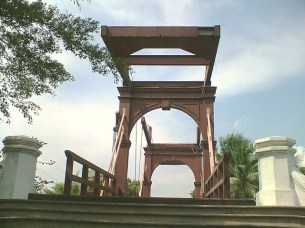
The old drawbridge (De Hoenderpasar ophaalbrug) old city Batavia (foto: arie saksono)
The cannon is known as Portuguese cannon, made by MT Bocarro in Macao to strengthen the Portuguese fort in Malacca. It was brought to Batavia by the Dutch after the fall of Malacca in 1641. Then it was placed on a bastion of the old castle Batavia controlling the harbor. When the castle of Batavia was demolished by Governor General Deandels in 1809, the cannon had been forgotten of just left behind because of its heavy weight.
The cannon bear the Latin inscription: “EX ME IPSA RENATA SUM” (-out of my self I was reborn-) this may allude to the fact that it was recast from an older one. Other source said that it was remade from 16 small cannons. The body is made from iron metal with total length of 380 cm. The diameter of snout of the frontage cannon is 39 cm (inner) and 50 cm (circular outer), cannon snout 158 cm, circular of smallest cannon body 122 cm, circular of biggest cannon body 206 cm, wide of cannon body is 100 cm. The total weight of the cannon is 7000 pound or 3, 5 ton. The serial number is 27012.
The cannon shows the special design of a clenched fist “Mano in fica” which in Indonesia is a symbol of cohabitation. For that reason it was once reputed to a font of fertility. Women used to offer flowers before this talisman on Thursday, concluding their ritual by sitting on top of it or just stroke the fist. To counteract this superstition the cannon was transferred to a museum for some years.
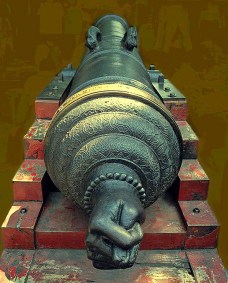
Symbol “Mano in fica” (foto: arie saksono)
Javanese story about Si Jagur
There is also a Javanese story about Si Jagur. It tells us that the King of Pajajaran or Sunda once had a bad dream in which he heard the thunder of a powerful weapon unknown to his people. He ordered his prime minister, the Patih, to look for such a weapon. He even threatened the man, whose name Kyai Setomo, with death if he failed to produce the wonder weapon of the king’s dream. The patih went home and discussed his sad and bitter fate with his wife. Then they closed their home in order to Semedi, to meditate. After some days waiting in vain for news from his Patih the king became angry. He sent his soldiers to search Kyai Setomo’s house, but they didn’t find the man, but only two big strange pipes. When the king himself rushed to see the strange things, he immediately recognized them as the weapon he heard in his dream. It appeared that the Patih Kyai Setomo and his wife Nyai Setomi had been transformed into two cannons.
Not long after this happened the great king of central Java, Sultan Agung, heard about it and ordered both cannons to be bought immediately to his capital Solo. But the male cannon Kyai Setomo, refused to move to the court of the sultan and fled on his own strength back to Batavia. Because it was night he could not enter the castle which was already closed. So he stayed at the gates. The next morning the people of Batavia were very astonished and regarded the cannon as Keramat (holy), offering little paper umbrella to protect him from the heat of the day, flowers and many other kind of offerings. They called him Kyai Jagur, “Hon. Mr. Robust (or Mr. Fertility). His wife, Nyai Setomi was taken to Solo, where she still rests today lonely and sometimes weeping..
Source :
Heuken SJ, Adolf., Historical Sites of Jakarta, Jakarta: Yayasan Cipta Loka Caraka, 1982
Other written and spoken sources
©2007 arie saksono
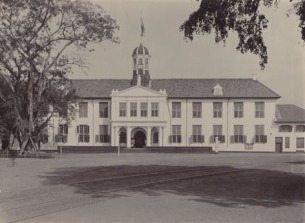



 Posted by saksonoarie
Posted by saksonoarie 
